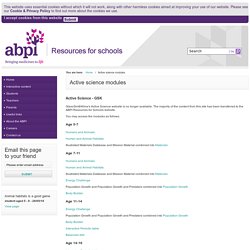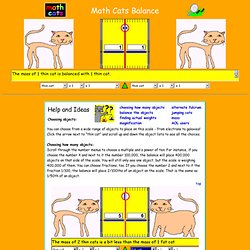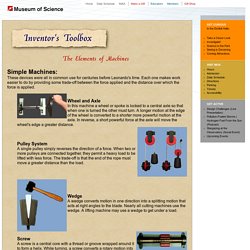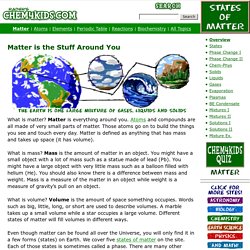

Simple Machines Made Simple. Photo.
ANIMALS - amphibians, birds, fish, insects, mammals, reptiles. Cool Science for Curious Kids. Endangered TV. Animal Videos, Photos, Facts. Online physics-based games. Interactives. Argosy Medical Animation. Brain Food. Human Anatomy Biology. Anatomy Arcade - anatomy games and interactives. Global Broadcast 4 Kids. ActiveScience - GSK. GlaxoSmithKline's Active Science website is no longer available.

The majority of the content from this site has been transferred to the ABPI Resources for Schools website. You may access the modules as follows: Age 5-7 Humans and Animals Human and Animal Habitats Illustrated Materials Database and Mission Material combined into Materials Age 7-11 Energy Challenge Population Growth and Population Growth and Predators combined into Population Growth Body Builder Age 11-14 Interactive Periodic table Balanced diet Age 14-16 Enzymes in Biotechnology Age 16+ The following modules have not been transferred; if you wish to use the information from one of these modules please contact ABPI at abpischools@abpi.org.uk The Heart Elements Database Selective Breeding and Genetic Engineering Please note that there are interactive resources on the ABPI site covering the Heart and Circulation, Digestion and Genes and Inheritance.
Schools Science Clips - Friction. Schools Science Clips - Forces in action. Engineering Interact - Interactive science & engineering for 9-11 year olds. Math Cats Balance. Choosing how many objects:Scroll through the number menus to choose a multiple and a power of ten.

For instance, if you choose the number 4 and next to it the number 100,000, the balance will place 400,000 objects on that side of the scale. You will still only see one object, but the scale is weighing 400,000 of them. You can choose fractions, too. If you choose the number 2 and next to it the fraction 1/100, the balance will place 2/100ths of an object on the scale. That is the same as 1/50th of an object. top .
How to balance the objects: Experiment with the number of objects to place on the balance. When you are comparing two objects of very different mass, you might multiply one object by a large number and multiply the other side by a fraction. Not every pairing of objects can be balanced if the difference in their mass is too vast. OLogy. InventorsToolbox: The Elements of Machines. Simple Machines: These devices were all in common use for centuries before Leonardo's time.

Each one makes work easier to do by providing some trade-off between the force applied and the distance over which the force is applied. Wheel and Axle In this machine a wheel or spoke is locked to a central axle so that when one is turned the other must turn. A longer motion at the edge of the wheel is converted to a shorter more powerful motion at the axle. In reverse, a short powerful force at the axle will move the wheel's edge a greater distance. Pulley System A single pulley simply reverses the direction of a force. Wedge A wedge converts motion in one direction into a splitting motion that acts at right angles to the blade. Screw A screw is a central core with a thread or groove wrapped around it to form a helix.
Lever A lever is a stiff rod that rotates around a pivot point. Gears Gears are toothed or pegged wheels meshed together to transmit motion and force. For YOUR KIDS! Simple Machines Activities - Lever - Pulley - Wedge - Screw - Inclined Plane - Wheel and Axle - Gear.
I Spy … Simple Machines. Simple Machines. Simple Machines. Strange Matter. Matter. What is matter?

Matter is everything around you. Atoms and compounds are all made of very small parts of matter. Those atoms go on to build the things you see and touch every day. Matter is defined as anything that has mass and takes up space (it has volume). What is mass? What is volume? Even though matter can be found all over the Universe, you will only find it in a few forms (states) on Earth. What are the main states of matter? What makes a state of matter? What is a physical change in matter? So what is a chemical change in matter? Physical changes are related to changes in the immediate environment such as temperature, pressure, and other physical forces. Alien Matter in the Solar System (NASA Video) States of Matter. eChalk science preview: teaching resources, educational games and lesson activities for the classroom.
Bug Catcher! Game, Bugs, Museum Victoria, Australia. Global Warming, Climate Change, Green Days, Green Calendar, Green Club, Eco Club, Environment Education, E-Greetings, E-Cards, Children’s web site, CEE, Pankaj Gorana, Birds, Animal, Eco system, Class room project, Teacher resources, Centre. The Children's University of Manchester.
Science NetLinks: Resources for Teaching Science. The KidsKnowIt Network - Educational Websites For Kids. Defenders of Wildlife - Kids' Planet. MadSciNet: The 24-hour exploding laboratory. PASSPORT TO THE RAINFOREST. Exploring Ecosystems. Ecosystems. Endangered Ecosystems. Interactive Tutor: 3 - Ecosystems. Bill Moyers Reports: Earth on Edge - Interactive Quiz.
National Data.